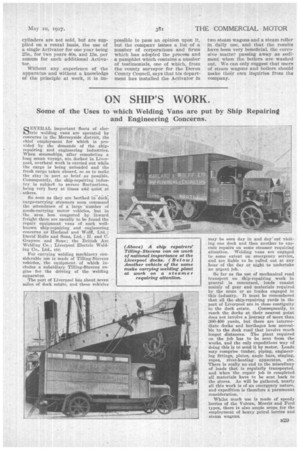ON SHIP'S WORK.
Page 55

If you've noticed an error in this article please click here to report it so we can fix it.
Some of the Uses to which Welding Vans are put by Ship Repairing and Engineering Concerns.
SEVERAL important fleets of electric welding vans are operated by concerns in the Merseyside district, the chief employment for which is provided by the demands of the shiprepairing and engineering industries. When steamships, after completing, a long ocean voyage, are docked in Liverpool, overhaul work is carried out while the cargo is being unloaded and the fresh cargo taken aboard, so as to make the stay in port as brief as possible. Consequently, the ship-repairing indus
try is subject to vere fluctuations, being very busy at times and quiet at others.
So soon as they are berthed in dock, cargo-carrying steamers soon command the attendance of a large number of goods-carrying motor vehicles, but in the area less congested by inward freight there are usually to be found the repair equipment vans of such wellknown ship-repairing and engineering concerns as Harland and Wolff. Ltd.; David Rollo and Sons, Ltd.; H. and C. Grayson and Sous; the British Are Welding Co.; Liverpool Electric Welding Co., Ltd., etc.
For carrying welding machinery considerable use is made of Tilling-Stovens vehicles; the equipment of which includes a subsidiary Tilling-Stevens engine for the driving of the welding apparatus.
The port of Liverpool has about seven miles of dock estate, and these vehicles may be seen day in and day' out one dock and then another to execute repairs on some steamer requiring attention. Welding vans are engaged to some extent on emergency service, and are liable to be called out at any hour of the day or night to undertake an urgent job.
So far as the use of mechanical road transport on ship-repairing work in general is concerned, loads consist mainly of gear and materials required by the score or so trades engaged in this industry. It must be remembered that all the ship-repairing yards in the port of Liverpool are in close contiguity to the dock estate. Consequently, to reach the docks at their nearest point does not involve a journey of more than 300-460 yards, but there are intermediate docks and berthages less accessible to the dock road that involve much longer Jilstances. The plant required on the job has to be sent from the works, and the only expeditious way of doing this is to send it by motor. Loads may comprise timber, piping, engineering fittings, plates, angle bars, staging, ropes, rivet-heating apparatus, etc. There is really no end to the miscellany of loads that is regularly transported. and when the repair job is completed all materials have to be sent back to the stores. As will be gathered, nearly all this work is of an emergency nature, and expedition is therefore a paramount consideration.
Whilst much use is made of speedy lorries of the Vulcan, Morris and Ford types, there is also ample scope for the employment of heavy petrol lorries and steam wagons.




















































































































